Wood Sanding Machine Market
Wood Sanding Machine Market Size and Share Forecast Outlook 2025 to 2035
Wood sanding machine market is projected to grow from USD 1.4 billion in 2025 to USD 1.9 billion by 2035, at a CAGR of 3.6%. Wide-Belt Sanders will dominate with a 40.0% market share, while automatic cnc lines will lead the operation segment with a 38.0% share.
Wood Sanding Machine Market Forecast and Outlook 2025 to 2035
The global wood sanding machine market is valued at USD 1,350.0 million in 2025. It is slated to reach USD 1,923.0 million by 2035, recording an absolute increase of USD 573.0 million over the forecast period. This translates into a total growth of 42.4%, with the market forecast to expand at a compound annual growth rate (CAGR) of 3.6% between 2025 and 2035. The overall market size is expected to grow by nearly 1.42X during the same period, supported by increasing furniture manufacturing demand, growing construction industry development, expanding engineered wood production, and rising automation adoption in woodworking operations.
The growth of the global wood sanding machine market is being driven by a combination of industrial, technological, and market dynamics that are reshaping woodworking operations worldwide. A key driver is the steady increase in furniture manufacturing demand, particularly in emerging economies where rising disposable incomes, urbanization, and evolving consumer lifestyles are fueling the need for high-quality, aesthetically appealing wooden furniture. Wood sanding machines play a critical role in enhancing surface finish, precision, and overall product quality, making them indispensable in both large-scale industrial production and smaller artisanal workshops.
The construction sector is another major contributor to market expansion. Growing infrastructure development, residential construction projects, and commercial real estate ventures are increasing the demand for wooden components, panels, and decorative elements, which require precise surface finishing. Sanding machines, ranging from belt sanders to wide-belt and orbital sanding systems, enable manufacturers to meet quality standards, reduce production defects, and enhance efficiency, thereby driving adoption across construction-related woodworking operations.
Expansion in engineered wood production, including plywood, MDF, particleboard, and laminated timber, further supports market growth. Engineered wood products require consistent sanding and finishing to achieve uniform thickness, smooth surfaces, and improved bonding for laminates and coatings. Modern sanding machines with automated feed systems, multi-head configurations, and real-time process control allow manufacturers to maintain high throughput while minimizing labor dependency, making these machines attractive investments in automated production lines.
Technological innovation is also shaping market trends. Manufacturers are increasingly incorporating advanced automation, robotics, and IoT-enabled monitoring in sanding machines to enhance precision, reduce material wastage, and enable predictive maintenance. Energy-efficient motors, dust collection integration, and user-friendly interfaces are becoming standard features, meeting both operational and environmental sustainability objectives.
Geographically, North America and Europe remain prominent markets due to their mature woodworking industries, stringent quality standards, and high adoption of automated solutions. Meanwhile, Asia-Pacific is witnessing rapid growth driven by the expansion of furniture manufacturing hubs, rising construction activities, and growing industrial investment in automation technologies. Overall, the wood sanding machine market is poised for steady expansion through 2035, underpinned by growing demand for high-quality wood products, automation adoption, and technological advancements that enhance productivity, precision, and operational sustainability across woodworking industries.
Quick Stats for Wood Sanding Machine Market
- Wood Sanding Machine Market Value (2025): USD 1,350.0 million
- Wood Sanding Machine Market Forecast Value (2035): USD 1,923.0 million
- Wood Sanding Machine Market Forecast CAGR: 3.6%
- Leading Machine Type in Wood Sanding Machine Market: Wide-Belt Sanders
- Key Growth Regions in Wood Sanding Machine Market: Asia-Pacific, Europe, and North America
- Key Players in Wood Sanding Machine Market: Biesse, SCM Group, HOMAG, Timesavers, Costa Levigatrici, Weinig
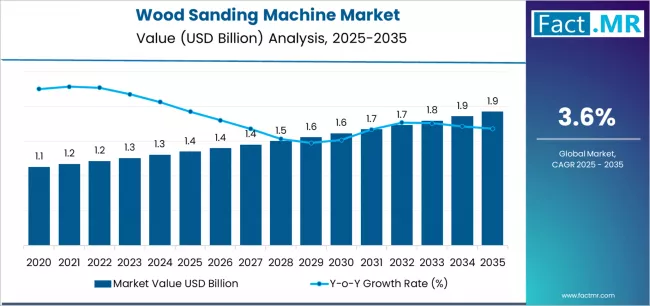
Between 2025 and 2030, the wood sanding machine market is projected to expand from USD 1,350.0 million to USD 1,610.0 million, resulting in a value increase of USD 260.0 million, which represents 45.4% of the total forecast growth for the decade. This phase of development will be shaped by increasing industrial automation adoption, growing furniture export markets, and expanding engineered wood applications. Machine manufacturers and woodworking companies are expanding their sanding machine capabilities to address the growing demand for efficient and precision wood finishing solutions.
Wood Sanding Machine Market Key Takeaways
| Metric | Value |
|---|---|
| Estimated Value in (2025E) | USD 1,350.0 million |
| Forecast Value in (2035F) | USD 1,923.0 million |
| Forecast CAGR (2025 to 2035) | 3.6% |
From 2030 to 2035, the market is forecast to grow from USD 1,610.0 million to USD 1,923.0 million, adding another USD 313.0 million, which constitutes 54.6% of the overall ten-year expansion. This period is expected to be characterized by the expansion of smart manufacturing technologies, development of energy-efficient sanding systems, and growth of customized finishing solutions for specialized wood products. The growing adoption of Industry 4.0 principles and digital manufacturing will drive demand for wood sanding machines with enhanced automation and precision capabilities.
Between 2020 and 2025, the wood sanding machine market experienced steady growth, driven by recovering construction activities and growing recognition of wood sanding machines as essential equipment for quality wood finishing and surface preparation. The market developed as woodworking manufacturers and furniture producers recognized the potential for advanced sanding technology to improve product quality, reduce processing time, and support competitive positioning while meeting increasing quality standards and production efficiency requirements.
Why is the Wood Sanding Machine Market Growing?
Market expansion is being supported by the increasing global furniture production driven by urbanization and housing development, alongside the corresponding need for efficient wood finishing equipment that can enhance surface quality, improve production efficiency, and maintain consistent finishing standards across various woodworking and furniture manufacturing applications. Modern woodworking companies and furniture manufacturers are increasingly focused on implementing advanced sanding machine solutions that can optimize finishing processes, reduce labor costs, and provide superior surface quality while maintaining operational efficiency and competitive positioning.
The growing emphasis on automation and precision manufacturing is driving demand for wood sanding machines that can support consistent quality control, enable high-volume production, and ensure comprehensive finishing capabilities through advanced control systems and automated operation features. Manufacturers' preference for equipment that combines productivity enhancement with quality assurance and operational efficiency is creating opportunities for innovative sanding machine implementations. The rising influence of sustainable manufacturing and energy efficiency requirements is also contributing to increased adoption of wood sanding machines that can provide superior performance characteristics without compromising environmental compliance or operational costs.
Segmental Analysis
The market is segmented by machine type, operation, end use, and sales channel. By machine type, the market is divided into wide-belt sanders, orbital/random orbit, drum/brush sanders, and edge/profile sanders. Based on operation, the market is categorized into automatic CNC lines, semi-automatic, and portable/handheld pro. By end use, the market is segmented into furniture & cabinetry, panel/engineered wood, flooring/doors, and joinery/other applications. By sales channel, the market is divided into industrial OEM/lines, dealers/distributors, and online/direct channels.
By Machine Type, the Wide-Belt Sanders Segment Leads the Market
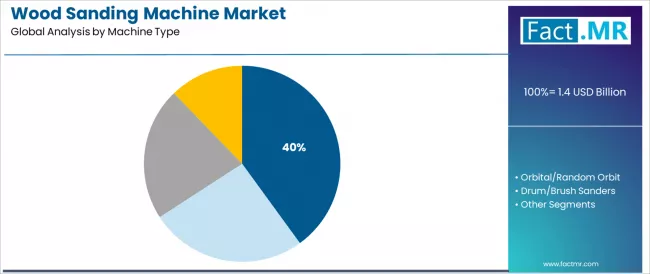
The wide-belt sanders segment is projected to maintain its leading position in the wood sanding machine market in 2025 with a 40.0% market share, reaffirming its role as the preferred machine type for industrial wood finishing and high-volume production applications.
Woodworking manufacturers and furniture producers increasingly utilize wide-belt sanders for their superior finishing capabilities, high processing speeds, and proven effectiveness in handling large wood panels while maintaining consistent surface quality and dimensional accuracy. Wide-belt sander technology's proven effectiveness and industrial scalability directly address industry requirements for efficient production and quality finishing across diverse wood processing applications and manufacturing environments.
This machine segment forms the foundation of modern industrial wood finishing, as it represents the technology with the greatest contribution to production efficiency and established performance record across multiple woodworking sectors and manufacturing scales.
Woodworking industry investments in wide-belt sander technologies continue to strengthen adoption among manufacturers and production facilities. With industrial requirements demanding high productivity and consistent quality, wide-belt sanders align with both efficiency objectives and quality assurance requirements, making them the central component of comprehensive wood finishing strategies.
By Operation, the Automatic CNC Lines Segment Dominates Market Demand
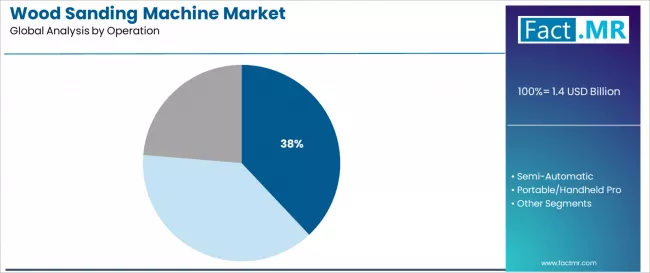
The automatic CNC lines operation segment is projected to represent the largest share of wood sanding machine demand in 2025 with a 38.0% market share, underscoring its critical role as the primary driver for advanced wood sanding adoption across automated manufacturing facilities and high-volume production operations.
Manufacturers prefer automatic CNC sanding lines for their exceptional precision capabilities, consistent quality output, and proven effectiveness in reducing labor costs while supporting complex finishing requirements and integrated production workflows. Positioned as essential equipment for modern manufacturing, automatic CNC lines offer both productivity advantages and quality consistency benefits.
The segment is supported by continuous innovation in automation technology and the growing availability of intelligent sanding systems that enable superior process control with enhanced efficiency and reduced waste generation. Manufacturers are investing in comprehensive automation programs to support increasingly sophisticated wood finishing requirements and competitive manufacturing demands.
As automation adoption increases and quality standards advance, the automatic CNC lines operation will continue to dominate the market while supporting advanced manufacturing strategies and operational excellence optimization.
What are the Drivers, Restraints, and Key Trends of the Wood Sanding Machine Market?
The wood sanding machine market is advancing steadily due to increasing furniture production driven by global construction and housing development, alongside growing demand for automated wood finishing equipment that provides consistent quality, improved efficiency, and reduced labor requirements across various woodworking and manufacturing applications. However, the market faces challenges, including high initial investment costs for advanced systems, skilled operator requirements for complex machinery, and competition from alternative finishing technologies. Innovation in automation technology and energy-efficient designs continues to influence equipment adoption and market expansion patterns.
Expansion of Furniture Manufacturing and Construction Industries
The growing furniture manufacturing sector is driving demand for wood sanding machines that can handle increased production volumes, maintain consistent quality standards, and support diverse wood species and product formats through advanced sanding technologies and flexible operation capabilities. Furniture manufacturers require sophisticated sanding equipment that delivers superior surface preparation across multiple wood types while maintaining cost-effectiveness and production efficiency. Woodworking companies are increasingly recognizing the competitive advantages of advanced sanding technology for product quality enhancement and market competitiveness, creating opportunities for specialized equipment designed for furniture production requirements and quality differentiation.
Integration of Automation and Industry 4.0 Technologies
Modern wood sanding machine manufacturers are incorporating automation technologies and Industry 4.0 capabilities to enhance operational efficiency, reduce labor requirements, and support comprehensive quality control through intelligent control systems and data analytics integration. Leading companies are developing smart sanding systems, implementing predictive maintenance capabilities, and advancing automation technologies that optimize sanding operations while maintaining equipment reliability and product quality. These technologies improve operational efficiency while enabling new manufacturing opportunities, including lights-out production, remote monitoring, and data-driven process optimization.
Development of Energy-Efficient and Sustainable Technologies
The expansion of environmental consciousness and energy cost concerns is driving demand for energy-efficient wood sanding machines with reduced power consumption, improved dust collection systems, and sustainable operation characteristics that address environmental regulations and operational cost optimization. These advanced systems require sophisticated engineering capabilities and environmental control technologies that exceed traditional sanding equipment requirements, creating premium market segments with enhanced sustainability credentials. Manufacturers are investing in green technology development and energy optimization to serve environmentally conscious applications while supporting innovation in sustainable manufacturing and environmental compliance.
Analysis of the Wood Sanding Machine Market by Key Countries
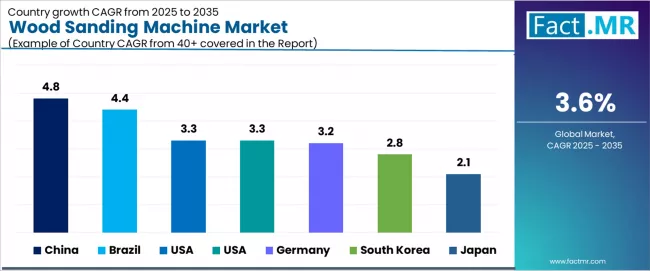
| Country | CAGR (2025-2035) |
|---|---|
| China | 4.8% |
| Brazil | 4.4% |
| USA | 3.3% |
| UK | 3.3% |
| Germany | 3.2% |
| South Korea | 2.8% |
| Japan | 2.1% |
The wood sanding machine market is experiencing solid growth globally, with China leading at a 4.8% CAGR through 2035, driven by massive furniture manufacturing capacity, expanding construction industry, and growing export-oriented wood processing supporting equipment demand.
Brazil follows at 4.4%, supported by abundant forest resources, expanding furniture industry, and increasing domestic construction activities. Europe shows growth at 3.4%, emphasizing advanced manufacturing technologies, premium furniture production, and automation adoption.
The USA demonstrates 3.3% growth, supported by construction recovery, furniture manufacturing reshoring, and advanced equipment adoption. The UK records 3.3%, focusing on furniture manufacturing efficiency and quality improvement.
Germany exhibits 3.2% growth, emphasizing engineering excellence and premium machinery development. South Korea shows 2.8% growth, supported by advanced manufacturing capabilities. Japan demonstrates 2.1% growth, focusing on precision equipment and technological innovation.
China Leads Global Market Growth with Manufacturing Capacity Expansion
Revenue from wood sanding machines in China is projected to exhibit exceptional growth with a CAGR of 4.8% through 2035, driven by massive furniture manufacturing capacity and rapidly expanding construction industry supporting equipment demand among furniture producers, wood processors, and manufacturing facilities. The country's extensive manufacturing infrastructure and increasing export market development are creating substantial demand for wood sanding machine solutions. Major furniture manufacturers and wood processing companies are establishing comprehensive production capabilities to serve both domestic markets and global export opportunities.
- Strong furniture manufacturing sector and export market development are driving demand for wood sanding machines throughout major manufacturing regions and industrial clusters across furniture plants, wood processing facilities, and manufacturing centers.
- Growing construction industry and engineered wood production are supporting the rapid adoption of advanced sanding technologies among manufacturers seeking enhanced productivity and competitive advantages in global markets.
Brazil Demonstrates Strong Market Potential with Forest Resources Utilization
Revenue from wood sanding machines in Brazil is expanding at a CAGR of 4.4%, supported by the country's abundant forest resources, expanding furniture industry, and increasing domestic construction activities driving demand for wood processing equipment and finishing technologies. The country's natural resource advantages and growing manufacturing capabilities are driving sophisticated wood sanding machine demand throughout various industrial sectors. Leading furniture manufacturers and wood processors are establishing extensive production facilities to address growing domestic and export demand.
- Strong forest resources and expanding furniture industry are creating opportunities for wood sanding machine adoption across wood processing facilities, furniture manufacturers, and construction material producers in major forestry regions.
- Growing domestic construction activities and furniture demand are driving adoption of efficient sanding technologies among manufacturers seeking improved productivity and quality enhancement for competitive positioning.
USA Focuses on Manufacturing Recovery and Equipment Modernization
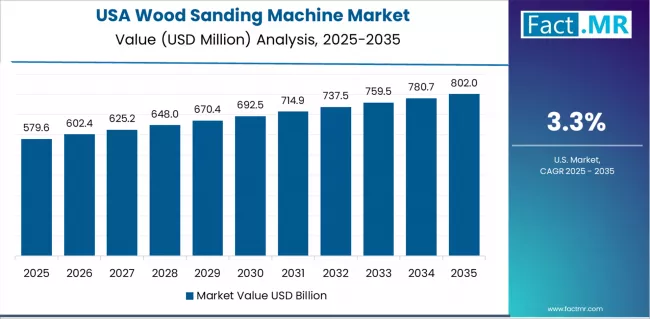
Revenue from wood sanding machines in the USA is expanding at a CAGR of 3.3%, driven by the country's construction industry recovery, furniture manufacturing reshoring initiatives, and advanced equipment adoption supporting domestic wood processing capacity development. The USA's manufacturing revitalization and technology advancement are supporting investment in modern wood sanding technologies. Major furniture companies and wood processors are establishing comprehensive modernization programs incorporating advanced sanding equipment.
- Construction recovery and furniture manufacturing reshoring are creating demand for modern wood sanding machines throughout furniture producers, cabinet manufacturers, and wood processing facilities across major manufacturing regions.
- Strong technology adoption and equipment modernization trends are driving the adoption of advanced sanding systems among manufacturers seeking competitive advantages and operational efficiency improvements.
UK Shows Market Leadership with Manufacturing Efficiency Focus
Revenue from wood sanding machines in the UK is expanding at a CAGR of 3.3%, supported by the country's furniture manufacturing efficiency initiatives, quality improvement focus, and technological advancement supporting wood sanding equipment adoption across diverse manufacturing applications. The UK's manufacturing optimization trends and quality standards are driving demand for efficient wood sanding solutions. Leading furniture companies and wood processors are investing in advanced equipment and manufacturing efficiency improvements.
- Manufacturing efficiency focus and quality improvement initiatives are creating opportunities for wood sanding machines throughout furniture manufacturers, joinery operations, and specialty wood processors serving quality-focused market segments.
- Strong technology adoption and manufacturing modernization trends are driving the adoption of advanced sanding equipment across production facilities seeking enhanced competitiveness and operational excellence.
Germany Demonstrates Engineering Excellence with Premium Machinery Development
Revenue from wood sanding machines in Germany is expanding at a CAGR of 3.2%, supported by the country's engineering excellence, premium machinery development capabilities, and advanced manufacturing standards supporting sophisticated wood sanding equipment production and utilization. The nation's machinery expertise and quality focus are driving demand for premium wood sanding machine solutions. Leading machinery manufacturers are investing extensively in advanced technology development and precision equipment manufacturing.
- Advanced engineering capabilities and premium machinery focus are creating demand for sophisticated wood sanding machines throughout high-end furniture manufacturers and precision woodworking facilities serving premium market segments.
- Strong machinery development expertise and quality standards are supporting the adoption of precision sanding equipment designed for advanced manufacturing applications and specialized wood processing requirements.
South Korea Demonstrates Advanced Manufacturing with Technology Integration
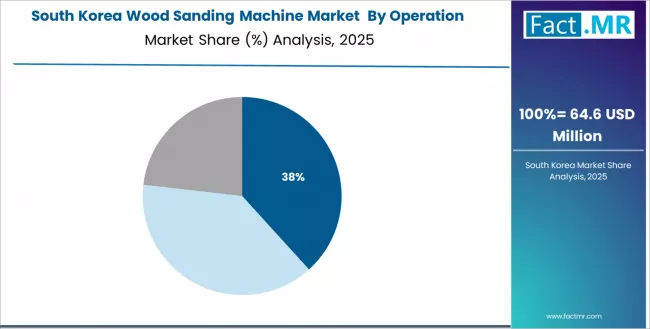
Revenue from wood sanding machines in South Korea is expanding at a CAGR of 2.8%, supported by the country's advanced manufacturing capabilities, technology integration focus, and growing emphasis on automation and quality improvement supporting wood sanding equipment adoption. The nation's manufacturing sophistication and technology advancement are driving demand for intelligent wood sanding solutions. Leading manufacturing companies are investing extensively in automated equipment and smart manufacturing technologies.
- Advanced manufacturing capabilities and automation focus are creating demand for intelligent wood sanding machines throughout furniture manufacturers and wood processing facilities seeking technological advancement and competitive positioning.
- Strong technology integration and smart manufacturing trends are supporting the adoption of automated sanding systems designed for advanced production requirements and quality optimization.
Japan Shows Premium Focus with Precision Equipment Excellence
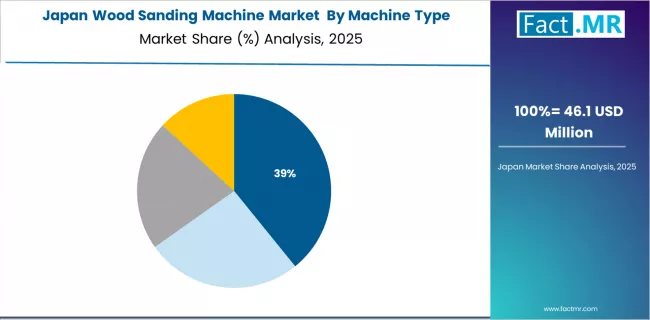
Revenue from wood sanding machines in Japan is expanding at a CAGR of 2.1%, supported by the country's precision equipment excellence, advanced manufacturing standards, and strong emphasis on quality and technological innovation supporting premium wood sanding equipment utilization. Japan's technological sophistication and quality consciousness are driving demand for precision wood sanding machine products. Leading machinery companies are investing in specialized capabilities for precision equipment applications and advanced technology development.
- Advanced precision manufacturing and quality focus are creating opportunities for premium wood sanding machines throughout high-end furniture producers and precision woodworking facilities serving specialized applications and quality-critical requirements.
- Strong technology innovation and precision equipment emphasis are driving adoption of advanced sanding systems meeting Japanese manufacturing standards for excellence and technological sophistication across diverse applications.
Europe Market Split by Country
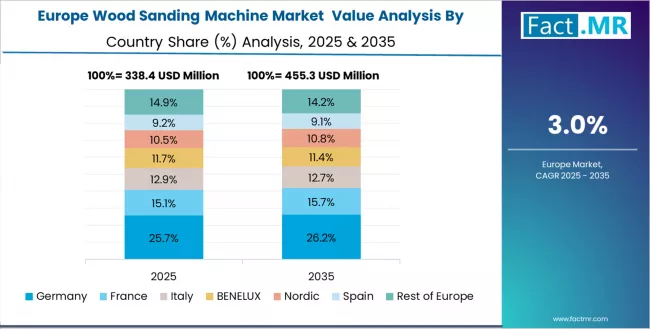
The wood sanding machine market in Europe is projected to grow from USD 462.0 million in 2025 to USD 650.0 million by 2035, registering a CAGR of 3.4% over the forecast period. Germany is expected to maintain leadership with a 32.5% market share in 2025, moderating to 32.2% by 2035, supported by engineering excellence, premium machinery development, and advanced manufacturing capabilities.
Italy follows with 24.7% in 2025, projected to reach 25.0% by 2035, driven by furniture industry leadership, design excellence, and premium woodworking traditions. France holds 16.3% in 2025, expected to reach 16.5% by 2035 due to luxury furniture production and quality craftsmanship focus. The United Kingdom commands 14.9% in 2025, rising to 15.0% by 2035, while Spain accounts for 7.8% in 2025, reaching 7.9% by 2035. The Rest of Europe region is anticipated to hold 3.8% in 2025 and 3.4% by 2035, reflecting steady woodworking equipment adoption in Nordic countries and emerging manufacturing markets in Eastern European countries.
Competitive Landscape of the Wood Sanding Machine Market
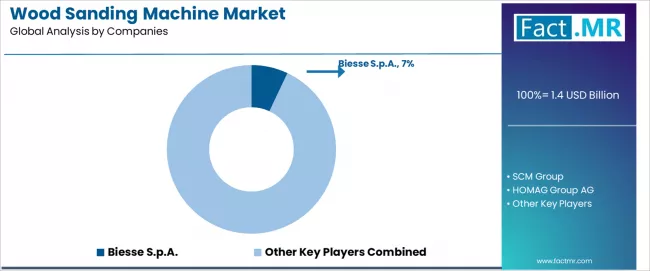
The wood sanding machine market is characterized by competition among established machinery manufacturers, specialized woodworking equipment companies, and integrated industrial solution providers. Companies are investing in automation technology development, precision engineering advancement, energy efficiency improvement, and comprehensive service capabilities to deliver high-performance, reliable, and cost-effective wood sanding machine solutions. Innovation in smart manufacturing integration, dust collection systems, and customized finishing capabilities is central to strengthening market position and competitive advantage.
Biesse leads the market with a 7.0% share, offering comprehensive wood sanding machine solutions with focus on automation integration, advanced control systems, and extensive global service networks serving diverse woodworking and furniture manufacturing applications. The company continues investing in Industry 4.0 technologies and smart manufacturing solutions while expanding production capacity and technical support capabilities.
SCM Group provides integrated woodworking solutions with emphasis on productivity and precision. HOMAG specializes in automated production lines and intelligent manufacturing systems. Timesavers focuses on wide-belt sanding technology and industrial applications. Costa Levigatrici emphasizes sanding innovation and Italian craftsmanship. Weinig offers comprehensive wood processing solutions with sanding integration.
Key Players in the Wood Sanding Machine Market
- Biesse S.p.A.
- SCM Group
- HOMAG Group AG
- Timesavers, Inc.
- Costa Levigatrici S.r.l.
- Weinig AG
- Makita Corporation (Professional Division)
- Festool GmbH (Professional Division)
- JET Tools
- Laguna Tools
Scope of the Report
| Items | Values |
|---|---|
| Quantitative Units (2025) | USD 1,350.0 Million |
| Machine Type | Wide-Belt Sanders, Orbital/Random Orbit, Drum/Brush Sanders, Edge/Profile Sanders |
| Operation | Automatic CNC Lines, Semi-Automatic, Portable/Handheld Pro |
| End Use | Furniture & Cabinetry, Panel/Engineered Wood, Flooring/Doors, Joinery/Other |
| Sales Channel | Industrial OEM/Lines, Dealers/Distributors, Online/Direct |
| Regions Covered | Asia-Pacific, Europe, North America, Latin America, Middle East & Africa |
| Countries Covered | China, Brazil, Germany, USA, UK, Japan, South Korea, and 40+ countries |
| Key Companies Profiled | Biesse, SCM Group, HOMAG, Timesavers, Costa Levigatrici, Weinig |
| Additional Attributes | Dollar sales by machine type and operation, regional demand trends, competitive landscape, technological advancements in sanding technology, automation development, energy efficiency innovation, and manufacturing optimization |
Wood Sanding Machine Market by Segments
-
Machine Type :
- Wide-Belt Sanders
- Orbital/Random Orbit
- Drum/Brush Sanders
- Edge/Profile Sanders
-
Operation :
- Automatic CNC Lines
- Semi-Automatic
- Portable/Handheld Pro
-
End Use :
- Furniture & Cabinetry
- Panel/Engineered Wood
- Flooring/Doors
- Joinery/Other
-
Sales Channel :
- Industrial OEM/Lines
- Dealers/Distributors
- Online/Direct
-
Region :
- Asia-Pacific
- China
- Japan
- South Korea
- India
- Australia
- Rest of Asia-Pacific
- Europe
- Germany
- United Kingdom
- France
- Italy
- Spain
- Netherlands
- Rest of Europe
- North America
- United States
- Canada
- Mexico
- Latin America
- Brazil
- Argentina
- Rest of Latin America
- Middle East & Africa
- Kingdom of Saudi Arabia
- South Africa
- Rest of Middle East & Africa
- Asia-Pacific
Table of Content
- Executive Summary
- Global Market Outlook
- Demand to side Trends
- Supply to side Trends
- Technology Roadmap Analysis
- Analysis and Recommendations
- Market Overview
- Market Coverage / Taxonomy
- Market Definition / Scope / Limitations
- Market Background
- Market Dynamics
- Drivers
- Restraints
- Opportunity
- Trends
- Scenario Forecast
- Demand in Optimistic Scenario
- Demand in Likely Scenario
- Demand in Conservative Scenario
- Opportunity Map Analysis
- Product Life Cycle Analysis
- Supply Chain Analysis
- Investment Feasibility Matrix
- Value Chain Analysis
- PESTLE and Porter’s Analysis
- Regulatory Landscape
- Regional Parent Market Outlook
- Production and Consumption Statistics
- Import and Export Statistics
- Market Dynamics
- Global Market Analysis 2020 to 2024 and Forecast, 2025 to 2035
- Historical Market Size Value (USD Million) Analysis, 2020 to 2024
- Current and Future Market Size Value (USD Million) Projections, 2025 to 2035
- Y to o to Y Growth Trend Analysis
- Absolute $ Opportunity Analysis
- Global Market Pricing Analysis 2020 to 2024 and Forecast 2025 to 2035
- Global Market Analysis 2020 to 2024 and Forecast 2025 to 2035, By Machine Type
- Introduction / Key Findings
- Historical Market Size Value (USD Million) Analysis By Machine Type , 2020 to 2024
- Current and Future Market Size Value (USD Million) Analysis and Forecast By Machine Type , 2025 to 2035
- Wide-Belt Sanders
- Orbital/Random Orbit
- Drum/Brush Sanders
- Edge/Profile Sanders
- Y to o to Y Growth Trend Analysis By Machine Type , 2020 to 2024
- Absolute $ Opportunity Analysis By Machine Type , 2025 to 2035
- Global Market Analysis 2020 to 2024 and Forecast 2025 to 2035, By Operation
- Introduction / Key Findings
- Historical Market Size Value (USD Million) Analysis By Operation, 2020 to 2024
- Current and Future Market Size Value (USD Million) Analysis and Forecast By Operation, 2025 to 2035
- Automatic CNC Lines
- Semi-Automatic
- Portable/Handheld Pro
- Y to o to Y Growth Trend Analysis By Operation, 2020 to 2024
- Absolute $ Opportunity Analysis By Operation, 2025 to 2035
- Global Market Analysis 2020 to 2024 and Forecast 2025 to 2035, By Region
- Introduction
- Historical Market Size Value (USD Million) Analysis By Region, 2020 to 2024
- Current Market Size Value (USD Million) Analysis and Forecast By Region, 2025 to 2035
- North America
- Latin America
- Western Europe
- Eastern Europe
- East Asia
- South Asia and Pacific
- Middle East & Africa
- Market Attractiveness Analysis By Region
- North America Market Analysis 2020 to 2024 and Forecast 2025 to 2035, By Country
- Historical Market Size Value (USD Million) Trend Analysis By Market Taxonomy, 2020 to 2024
- Market Size Value (USD Million) Forecast By Market Taxonomy, 2025 to 2035
- By Country
- USA
- Canada
- Mexico
- By Machine Type
- By Operation
- By Country
- Market Attractiveness Analysis
- By Country
- By Machine Type
- By Operation
- Key Takeaways
- Latin America Market Analysis 2020 to 2024 and Forecast 2025 to 2035, By Country
- Historical Market Size Value (USD Million) Trend Analysis By Market Taxonomy, 2020 to 2024
- Market Size Value (USD Million) Forecast By Market Taxonomy, 2025 to 2035
- By Country
- Brazil
- Chile
- Rest of Latin America
- By Machine Type
- By Operation
- By Country
- Market Attractiveness Analysis
- By Country
- By Machine Type
- By Operation
- Key Takeaways
- Western Europe Market Analysis 2020 to 2024 and Forecast 2025 to 2035, By Country
- Historical Market Size Value (USD Million) Trend Analysis By Market Taxonomy, 2020 to 2024
- Market Size Value (USD Million) Forecast By Market Taxonomy, 2025 to 2035
- By Country
- Germany
- UK
- Italy
- Spain
- France
- Nordic
- BENELUX
- Rest of Western Europe
- By Machine Type
- By Operation
- By Country
- Market Attractiveness Analysis
- By Country
- By Machine Type
- By Operation
- Key Takeaways
- Eastern Europe Market Analysis 2020 to 2024 and Forecast 2025 to 2035, By Country
- Historical Market Size Value (USD Million) Trend Analysis By Market Taxonomy, 2020 to 2024
- Market Size Value (USD Million) Forecast By Market Taxonomy, 2025 to 2035
- By Country
- Russia
- Poland
- Hungary
- Balkan & Baltic
- Rest of Eastern Europe
- By Machine Type
- By Operation
- By Country
- Market Attractiveness Analysis
- By Country
- By Machine Type
- By Operation
- Key Takeaways
- East Asia Market Analysis 2020 to 2024 and Forecast 2025 to 2035, By Country
- Historical Market Size Value (USD Million) Trend Analysis By Market Taxonomy, 2020 to 2024
- Market Size Value (USD Million) Forecast By Market Taxonomy, 2025 to 2035
- By Country
- China
- Japan
- South Korea
- By Machine Type
- By Operation
- By Country
- Market Attractiveness Analysis
- By Country
- By Machine Type
- By Operation
- Key Takeaways
- South Asia and Pacific Market Analysis 2020 to 2024 and Forecast 2025 to 2035, By Country
- Historical Market Size Value (USD Million) Trend Analysis By Market Taxonomy, 2020 to 2024
- Market Size Value (USD Million) Forecast By Market Taxonomy, 2025 to 2035
- By Country
- India
- ASEAN
- Australia & New Zealand
- Rest of South Asia and Pacific
- By Machine Type
- By Operation
- By Country
- Market Attractiveness Analysis
- By Country
- By Machine Type
- By Operation
- Key Takeaways
- Middle East & Africa Market Analysis 2020 to 2024 and Forecast 2025 to 2035, By Country
- Historical Market Size Value (USD Million) Trend Analysis By Market Taxonomy, 2020 to 2024
- Market Size Value (USD Million) Forecast By Market Taxonomy, 2025 to 2035
- By Country
- Kingdom of Saudi Arabia
- Other GCC Countries
- Turkiye
- South Africa
- Other African Union
- Rest of Middle East & Africa
- By Machine Type
- By Operation
- By Country
- Market Attractiveness Analysis
- By Country
- By Machine Type
- By Operation
- Key Takeaways
- Key Countries Market Analysis
- USA
- Pricing Analysis
- Market Share Analysis, 2024
- By Machine Type
- By Operation
- Canada
- Pricing Analysis
- Market Share Analysis, 2024
- By Machine Type
- By Operation
- Mexico
- Pricing Analysis
- Market Share Analysis, 2024
- By Machine Type
- By Operation
- Brazil
- Pricing Analysis
- Market Share Analysis, 2024
- By Machine Type
- By Operation
- Chile
- Pricing Analysis
- Market Share Analysis, 2024
- By Machine Type
- By Operation
- Germany
- Pricing Analysis
- Market Share Analysis, 2024
- By Machine Type
- By Operation
- UK
- Pricing Analysis
- Market Share Analysis, 2024
- By Machine Type
- By Operation
- Italy
- Pricing Analysis
- Market Share Analysis, 2024
- By Machine Type
- By Operation
- Spain
- Pricing Analysis
- Market Share Analysis, 2024
- By Machine Type
- By Operation
- France
- Pricing Analysis
- Market Share Analysis, 2024
- By Machine Type
- By Operation
- India
- Pricing Analysis
- Market Share Analysis, 2024
- By Machine Type
- By Operation
- ASEAN
- Pricing Analysis
- Market Share Analysis, 2024
- By Machine Type
- By Operation
- Australia & New Zealand
- Pricing Analysis
- Market Share Analysis, 2024
- By Machine Type
- By Operation
- China
- Pricing Analysis
- Market Share Analysis, 2024
- By Machine Type
- By Operation
- Japan
- Pricing Analysis
- Market Share Analysis, 2024
- By Machine Type
- By Operation
- South Korea
- Pricing Analysis
- Market Share Analysis, 2024
- By Machine Type
- By Operation
- Russia
- Pricing Analysis
- Market Share Analysis, 2024
- By Machine Type
- By Operation
- Poland
- Pricing Analysis
- Market Share Analysis, 2024
- By Machine Type
- By Operation
- Hungary
- Pricing Analysis
- Market Share Analysis, 2024
- By Machine Type
- By Operation
- Kingdom of Saudi Arabia
- Pricing Analysis
- Market Share Analysis, 2024
- By Machine Type
- By Operation
- Turkiye
- Pricing Analysis
- Market Share Analysis, 2024
- By Machine Type
- By Operation
- South Africa
- Pricing Analysis
- Market Share Analysis, 2024
- By Machine Type
- By Operation
- USA
- Market Structure Analysis
- Competition Dashboard
- Competition Benchmarking
- Market Share Analysis of Top Players
- By Regional
- By Machine Type
- By Operation
- Competition Analysis
- Competition Deep Dive
- Biesse S.p.A.
- Overview
- Product Portfolio
- Profitability by Market Segments (Product/Age /Sales Channel/Region)
- Sales Footprint
- Strategy Overview
- Marketing Strategy
- Product Strategy
- Channel Strategy
- SCM Group
- HOMAG Group AG
- Timesavers, Inc.
- Costa Levigatrici S.r.l.
- Weinig AG
- Makita Corporation (Professional Division)
- Festool GmbH (Professional Division)
- JET Tools
- Laguna Tools
- Biesse S.p.A.
- Competition Deep Dive
- Assumptions & Acronyms Used
- Research Methodology
List Of Table
- Table 1: Global Market Value (USD Million) Forecast by Region, 2020 to 2035
- Table 2: Global Market Value (USD Million) Forecast by Machine Type , 2020 to 2035
- Table 3: Global Market Value (USD Million) Forecast by Operation, 2020 to 2035
- Table 4: North America Market Value (USD Million) Forecast by Country, 2020 to 2035
- Table 5: North America Market Value (USD Million) Forecast by Machine Type , 2020 to 2035
- Table 6: North America Market Value (USD Million) Forecast by Operation, 2020 to 2035
- Table 7: Latin America Market Value (USD Million) Forecast by Country, 2020 to 2035
- Table 8: Latin America Market Value (USD Million) Forecast by Machine Type , 2020 to 2035
- Table 9: Latin America Market Value (USD Million) Forecast by Operation, 2020 to 2035
- Table 10: Western Europe Market Value (USD Million) Forecast by Country, 2020 to 2035
- Table 11: Western Europe Market Value (USD Million) Forecast by Machine Type , 2020 to 2035
- Table 12: Western Europe Market Value (USD Million) Forecast by Operation, 2020 to 2035
- Table 13: Eastern Europe Market Value (USD Million) Forecast by Country, 2020 to 2035
- Table 14: Eastern Europe Market Value (USD Million) Forecast by Machine Type , 2020 to 2035
- Table 15: Eastern Europe Market Value (USD Million) Forecast by Operation, 2020 to 2035
- Table 16: East Asia Market Value (USD Million) Forecast by Country, 2020 to 2035
- Table 17: East Asia Market Value (USD Million) Forecast by Machine Type , 2020 to 2035
- Table 18: East Asia Market Value (USD Million) Forecast by Operation, 2020 to 2035
- Table 19: South Asia and Pacific Market Value (USD Million) Forecast by Country, 2020 to 2035
- Table 20: South Asia and Pacific Market Value (USD Million) Forecast by Machine Type , 2020 to 2035
- Table 21: South Asia and Pacific Market Value (USD Million) Forecast by Operation, 2020 to 2035
- Table 22: Middle East & Africa Market Value (USD Million) Forecast by Country, 2020 to 2035
- Table 23: Middle East & Africa Market Value (USD Million) Forecast by Machine Type , 2020 to 2035
- Table 24: Middle East & Africa Market Value (USD Million) Forecast by Operation, 2020 to 2035
List Of Figures
- Figure 1: Global Market Pricing Analysis
- Figure 2: Global Market Value (USD Million) Forecast 2020-2035
- Figure 3: Global Market Value Share and BPS Analysis by Machine Type , 2025 and 2035
- Figure 4: Global Market Y to o to Y Growth Comparison by Machine Type , 2025-2035
- Figure 5: Global Market Attractiveness Analysis by Machine Type
- Figure 6: Global Market Value Share and BPS Analysis by Operation, 2025 and 2035
- Figure 7: Global Market Y to o to Y Growth Comparison by Operation, 2025-2035
- Figure 8: Global Market Attractiveness Analysis by Operation
- Figure 9: Global Market Value (USD Million) Share and BPS Analysis by Region, 2025 and 2035
- Figure 10: Global Market Y to o to Y Growth Comparison by Region, 2025-2035
- Figure 11: Global Market Attractiveness Analysis by Region
- Figure 12: North America Market Incremental Dollar Opportunity, 2025-2035
- Figure 13: Latin America Market Incremental Dollar Opportunity, 2025-2035
- Figure 14: Western Europe Market Incremental Dollar Opportunity, 2025-2035
- Figure 15: Eastern Europe Market Incremental Dollar Opportunity, 2025-2035
- Figure 16: East Asia Market Incremental Dollar Opportunity, 2025-2035
- Figure 17: South Asia and Pacific Market Incremental Dollar Opportunity, 2025-2035
- Figure 18: Middle East & Africa Market Incremental Dollar Opportunity, 2025-2035
- Figure 19: North America Market Value Share and BPS Analysis by Country, 2025 and 2035
- Figure 20: North America Market Value Share and BPS Analysis by Machine Type , 2025 and 2035
- Figure 21: North America Market Y to o to Y Growth Comparison by Machine Type , 2025-2035
- Figure 22: North America Market Attractiveness Analysis by Machine Type
- Figure 23: North America Market Value Share and BPS Analysis by Operation, 2025 and 2035
- Figure 24: North America Market Y to o to Y Growth Comparison by Operation, 2025-2035
- Figure 25: North America Market Attractiveness Analysis by Operation
- Figure 26: Latin America Market Value Share and BPS Analysis by Country, 2025 and 2035
- Figure 27: Latin America Market Value Share and BPS Analysis by Machine Type , 2025 and 2035
- Figure 28: Latin America Market Y to o to Y Growth Comparison by Machine Type , 2025-2035
- Figure 29: Latin America Market Attractiveness Analysis by Machine Type
- Figure 30: Latin America Market Value Share and BPS Analysis by Operation, 2025 and 2035
- Figure 31: Latin America Market Y to o to Y Growth Comparison by Operation, 2025-2035
- Figure 32: Latin America Market Attractiveness Analysis by Operation
- Figure 33: Western Europe Market Value Share and BPS Analysis by Country, 2025 and 2035
- Figure 34: Western Europe Market Value Share and BPS Analysis by Machine Type , 2025 and 2035
- Figure 35: Western Europe Market Y to o to Y Growth Comparison by Machine Type , 2025-2035
- Figure 36: Western Europe Market Attractiveness Analysis by Machine Type
- Figure 37: Western Europe Market Value Share and BPS Analysis by Operation, 2025 and 2035
- Figure 38: Western Europe Market Y to o to Y Growth Comparison by Operation, 2025-2035
- Figure 39: Western Europe Market Attractiveness Analysis by Operation
- Figure 40: Eastern Europe Market Value Share and BPS Analysis by Country, 2025 and 2035
- Figure 41: Eastern Europe Market Value Share and BPS Analysis by Machine Type , 2025 and 2035
- Figure 42: Eastern Europe Market Y to o to Y Growth Comparison by Machine Type , 2025-2035
- Figure 43: Eastern Europe Market Attractiveness Analysis by Machine Type
- Figure 44: Eastern Europe Market Value Share and BPS Analysis by Operation, 2025 and 2035
- Figure 45: Eastern Europe Market Y to o to Y Growth Comparison by Operation, 2025-2035
- Figure 46: Eastern Europe Market Attractiveness Analysis by Operation
- Figure 47: East Asia Market Value Share and BPS Analysis by Country, 2025 and 2035
- Figure 48: East Asia Market Value Share and BPS Analysis by Machine Type , 2025 and 2035
- Figure 49: East Asia Market Y to o to Y Growth Comparison by Machine Type , 2025-2035
- Figure 50: East Asia Market Attractiveness Analysis by Machine Type
- Figure 51: East Asia Market Value Share and BPS Analysis by Operation, 2025 and 2035
- Figure 52: East Asia Market Y to o to Y Growth Comparison by Operation, 2025-2035
- Figure 53: East Asia Market Attractiveness Analysis by Operation
- Figure 54: South Asia and Pacific Market Value Share and BPS Analysis by Country, 2025 and 2035
- Figure 55: South Asia and Pacific Market Value Share and BPS Analysis by Machine Type , 2025 and 2035
- Figure 56: South Asia and Pacific Market Y to o to Y Growth Comparison by Machine Type , 2025-2035
- Figure 57: South Asia and Pacific Market Attractiveness Analysis by Machine Type
- Figure 58: South Asia and Pacific Market Value Share and BPS Analysis by Operation, 2025 and 2035
- Figure 59: South Asia and Pacific Market Y to o to Y Growth Comparison by Operation, 2025-2035
- Figure 60: South Asia and Pacific Market Attractiveness Analysis by Operation
- Figure 61: Middle East & Africa Market Value Share and BPS Analysis by Country, 2025 and 2035
- Figure 62: Middle East & Africa Market Value Share and BPS Analysis by Machine Type , 2025 and 2035
- Figure 63: Middle East & Africa Market Y to o to Y Growth Comparison by Machine Type , 2025-2035
- Figure 64: Middle East & Africa Market Attractiveness Analysis by Machine Type
- Figure 65: Middle East & Africa Market Value Share and BPS Analysis by Operation, 2025 and 2035
- Figure 66: Middle East & Africa Market Y to o to Y Growth Comparison by Operation, 2025-2035
- Figure 67: Middle East & Africa Market Attractiveness Analysis by Operation
- Figure 68: Global Market - Tier Structure Analysis
- Figure 69: Global Market - Company Share Analysis
- FAQs -
How big is the wood sanding machine market in 2025?
The global wood sanding machine market is estimated to be valued at USD 1.4 billion in 2025.
What will be the size of wood sanding machine market in 2035?
The market size for the wood sanding machine market is projected to reach USD 1.9 billion by 2035.
How much will be the wood sanding machine market growth between 2025 and 2035?
The wood sanding machine market is expected to grow at a 3.6?GR between 2025 and 2035.
What are the key product types in the wood sanding machine market ?
The key product types in wood sanding machine market are wide-belt sanders, orbital/random orbit, drum/brush sanders and edge/profile sanders.
Which operation segment to contribute significant share in the wood sanding machine market in 2025?
In terms of operation, automatic cnc lines segment to command 38.0% share in the wood sanding machine market in 2025.